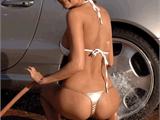Precautions and purposes of car film_ Auto Beauty Recruitment Network_ Sina Blog
Car Window Tinting: Precautions and Uses
I. Major Benefits of Tinting
II. Care Required After Installing New Film
III. Tips for Choosing the Right Film
1. Major Benefits of Car Window Tinting
A. Heat Reduction and Temperature Control
Everyone has experienced entering a car that's been sitting in the sun, feeling like you've walked into a sauna. Sunscreen films can help reduce this overheating effect by cutting down on solar radiation inside your vehicle. Professionals note that during hot summers, these films can decrease the need for air conditioning by 60%. Not only does it keep your car cooler, but it also saves energy from air conditioning usage, which is especially important with rising fuel prices. Tinting truly offers multiple benefits.
B. Skin Protection
The harmful effects of UV rays on skin are well known. They can cause burns, wrinkles, spots, and even more severe conditions like cataracts or skin cancer. For those who value their skin, spending time in a car without proper protection can be damaging. Good quality sunscreen films can block over 98% of UV rays, making them essential during the summer months.
C. Prevents Interior Cracking and Fading
Prolonged exposure to sunlight can cause car interiors to crack and fade. Sunscreen films not only protect your skin but also safeguard your car's interior, extending its lifespan.
D. Enhances Personal Safety
Many car owners may not know that sunscreen films can prevent glass shards from flying during accidents. In case of a crash, good quality film can hold shattered glass together, protecting the driver from injury.
E. Increases Privacy
Finally, these films can also deter thieves from peeping inside the car, ensuring both personal privacy and property safety.
2. Importance of Front Windshield Film
Some people choose to only tint the body of the car and leave the front windshield clear, fearing it will obstruct vision. However, not all heat-blocking films affect visibility. According to regulations by the Ministry of Transport, the front windshield must have at least 70% light transmission, while side windows near the driver should have at least 50%. Any film meeting these standards can be applied.
The front windshield film is crucial as 40% of the sun's heat enters through it. A good film significantly reduces the driver's discomfort in the sun, protects car equipment and leather seats from UV damage, and minimizes harm to the skin. In case of an accident where the glass shatters, the film can hold the pieces together, preventing injury to the driver. Renowned brands like Volvo, BMW, and Mercedes-Benz incorporate such films in their original glass layers, proving how necessary they are.
3. Care Required After Installing New Film
Experts suggest that after applying new film, one should take care to protect and maintain it, extending its lifespan. Specific measures include:
A. If bubbles appear between the film and the glass, it's best to return to the shop immediately for adjustments as beyond 24 hours, it becomes difficult to fix. Professional handling is recommended rather than DIY solutions. Note that slight water haze might appear between the newly applied film and glass, usually disappearing after 2-3 weeks as it dries out.
B. The car should not be washed until 2-3 weeks after installation when the film has dried completely. Use soft, clean cloths to avoid scratching the surface. Avoid using alcohol-based cleaners as they can cause the film to peel off.
C. Protect the edges of the film carefully, avoiding peeling them off. Similarly, side windows should remain closed for a few days after application and opened sparingly for the next 2-3 weeks to prevent accidental damage or contamination.
4. Choosing the Right Film
With numerous brands available at varying price points, choosing the right car film can be challenging. High-quality films involve advanced technology, so selecting wisely is crucial.
Car films have evolved through three stages: "tea paper," "anti-explosion film," and "sunscreen heat-insulating film."
"Tea paper" was the first generation product, known for strong shading and easy installation but lacked heat insulation, faded easily, and had adhesive issues.
"Anti-explosion film" represents the second generation, offering better heat resistance and UV protection with a 20%-60% heat reduction rate and around 80% UV blocking capability.
"Sunscreen heat-insulating film" is the third generation, boasting improved UV and infrared blocking rates (up to 90%-100% and 30%-95%, respectively). These films use stronger adhesives, reducing thickness while enhancing explosion-proof properties. Unlike regular sun films coated with color or aluminum powder, these employ metal plating, maintaining color stability over longer periods.
When selecting a film, clarity and transparency are key considerations. Regardless of color depth, the film should be highly transparent without any foggy appearance. Side window films, especially those for the front, should ideally have over 85% light transmission to ensure unobstructed vision, even during nighttime driving or rainy conditions.
Besides clarity and transparency, consider the film's heat insulation and anti-explosion properties. Quality films not only keep the car cool but also secure broken glass in case of an accident, ensuring passenger safety.
Lastly, while many opt for reputable brands, choosing a reliable shop for installation is equally important. Poorly equipped shops can lead to substandard installations and potential damage to the car and its glass, ultimately being counterproductive.
For more information on car window tinting, visit China Auto Beauty Recruitment Network at www.qcmrrc.com.



